Abstract
The goals of a “restoration” programme are often not clearly defined, which may radically influence the course of the change effected by the “restoration”. In this paper, I examine many restoration studies worldwide, the goals and the practice that was followed. Grasses often play an important role in both the succession and restoration processes. In Johannesburg, South Africa, wind-blown dust caused by gold mining was a problem in the early 20th century, so the goal was to stabilise the tailings. This was achieved by establishing vegetation on the dumps or revegetation of the land on which the tailings were deposited. Stabilisation of the Cape Flats was the goal in the late 19th century to allow easy movement along sandy roads in the region and marram grass was introduced from Europe specifically for this purpose. Revegetation with a different vegetation type is often a logical option where land use is of paramount importance. Replacement with crop plants or grasses is where the previous vegetation is replaced by an alternative land use that will be of benefit to the local people. The terms “rehabilitation” and “restoration” are often used interchangeably. Early researchers on the subject pointed out that rehabilitation is on the trajectory to full restoration or the original former state of the degraded site. In this review, the rehabilitation processes are discussed following dune mining in South Africa and at sites in Mozambique.
1. Introduction
In the 1980s, attention was drawn to the problems of the reclamation of derelict land by the work of Professor Tony Bradshaw and others [1,2,3]. These researchers achieved much to assess the aims and principles of restoration that have now been defined in a primer by the Society of Ecological Restoration [4]. In this paper, I examine many case studies, especially those that myself and colleagues have conducted on coastal dunes [5,6,7,8,9,10]. I have observed or played a role in projects in southern and eastern Africa over the past 50 years and have examined the goals and practices that have been followed. Grasses often play a crucial role in the initial stages [11,12]. An important aspect to understand is that restoration mimics natural succession and equates to “artificial succession”, as opposed to “natural succession”, which is sometimes called spontaneous restoration [6]. This is explained in more detail with respect to case studies.
Although many early studies were focused on degraded environments, it is only more recently that restoration and reclamation projects have been applied, as a concept, to all types of restoration, ranging from animal disturbance in natural areas through to the most severely degraded environments, as in, for example, the many types of new environments created by mining. Jordan et al. [13] provided a good account of the approach to the subject and a synthesis of knowledge as of 1990. In Europe, researchers have often adopted the term “reclamation”, as this implies the potential of land for future use, which may well be other than that of restoration of the natural ecosystem.
The terms used in ecology and those relevant to restoration, reclamation and rehabilitation have been well defined in the literature and are summarised in Box 1.
Box 1. Relevant concepts and definitions.
Ecology—‘The scientific study of the processes influencing the distribution and abundance of organisms, the interactions among organisms, and the interactions between organisms and the transformation and flux of energy and matter’ [14].
Succession—‘The replacement of populations by other populations better adapted to fill the ecological niche’ [15].
Restoration ecology—‘The return of a damaged ecosystem to its pre-disturbed condition, i.e., through the re-establishment of ecological attributes (both structural and functional) and related physical, chemical, and biological characteristics, and the process of renewing and maintaining ecosystem health’ [3,16,17,18].
Restoration—‘The return of a damaged ecosystem to its original state’ [19].
Reclamation—The process of returning a damaged ecosystem to a functional state whereby some use may be made of it. It implies creating the potential for future land use that may differ from the pre-disturbed state.
Rehabilitation—‘The process of returning a damaged ecosystem to its original state, taking into consideration that it is unlikely that complete restoration will be achieved’ [12,19].
Rewilding—A recent concept defined by the IUCN Rewilding Thematic Group as the process of rebuilding a natural ecosystem by restoring natural processes and the food-web at all trophic levels as a self-sustaining and resilient ecosystem using biota that would have been present if the disturbance not occurred [20].
The New Wild—A term introduced by Pearce [21] to describe a situation where one accepts the ecosystems as they are, having been modified by the introduction of invasive plants and animals by humans.
Novel ecosystems—Restoration ecologists have discovered that, in attempting to recreate the original ecosystem, an ecological threshold is often encountered and is difficult to overcome. This ‘new’ non-original state is the so-called novel ecosystem [22].
2. Objectives of this Paper
To examine restoration studies, the goals, and the practice that was followed.
3. Methodology
In my research in botany and restoration ecology, I have gained experience in many different fields of achieving change or improvement to disturbed environments, initially with work on gold-mine tailings on the Witwatersrand while based at the University of the Witwatersrand in Johannesburg. During this period, I visited the UK and had discussions with, and observed projects in restoration being conducted by, Professor Tony Bradshaw at the University of Liverpool and Professor Michael Chadwick at York University. As experts who had authored early studies on the reclamation of degraded land [1], I was able to gain valuable insights into alternative methods of rehabilitation. Especially useful was learning the experimental approach to reclamation that these researchers had developed.
I then moved to Rhodes University in Grahamstown and investigated the natural changes, over both short and long terms, in coastal systems, especially dune systems. In the 1970s and 1980s, dunes and estuaries on the Eastern Cape coast had been poorly studied. Consequently, together with colleagues at the University of Port Elizabeth (now Nelson Mandela University), we established a basic foundation for the study of coastal ecosystems in the greater Eastern Cape.
Our research then expanded into the Western Cape and KwaZulu-Natal coastal regions. With our experience in coastal systems and their management, my colleagues and I established an environmental consulting company, Coastal & Environmental Services (CES). This led to studies, mainly environmental impact assessments (EIAs) for prospective mines, in Mozambique and throughout Africa. Our experience in the field of restoration [19,23] has thus provided the many examples elaborated upon in Section 4.
In each case study outlined here, I have introduced the subject, formulated objectives, or goals of the study, explained the methods and results, followed by a discussion and conclusions. For greater detail on each of these case studies, the reader is referred to the many references cited on each project. In a map, I have shown the site of the many projects in Africa and the adjacent islands (Figure 1).
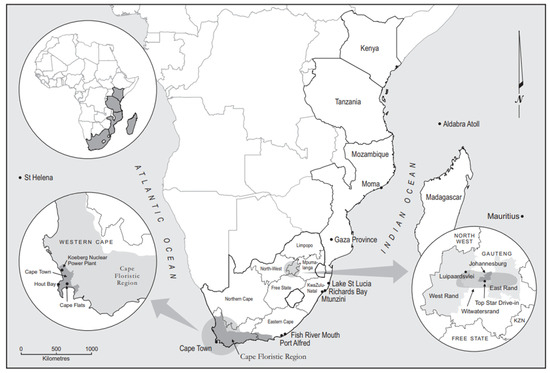
Figure 1.
Map of eastern and southern Africa and the islands of the Atlantic and Indian Oceans, showing the places mentioned in the text.
In Section 5 each of these projects or examples are further discussed and conclusions are drawn.
4. Examples of the Process of “Restoration” or “Rehabilitation” in Setting Goals and Conducting a Study
4.1. Establishing a Rehabilitation Plan
To conduct a successful rehabilitation, one also should establish a Rehabilitation Plan (Figure 2). This involves establishing a baseline or reference by documenting the state of the area for restoration prior to the implementation of the plan. This baseline can be compared with the end result of the restoration. First, the practitioner can list the goals to achieve the required end point, e.g., raising the pH and the organic content in the “soil” being rehabilitated, or achieving a certain percentage cover of specific plants or vegetation. Analysis of the progress of the restoration allows for modification and change of management goals during the procedure (Figure 2). With monitoring and review by comparison with reference sites, whether the goals have been achieved can be determined.
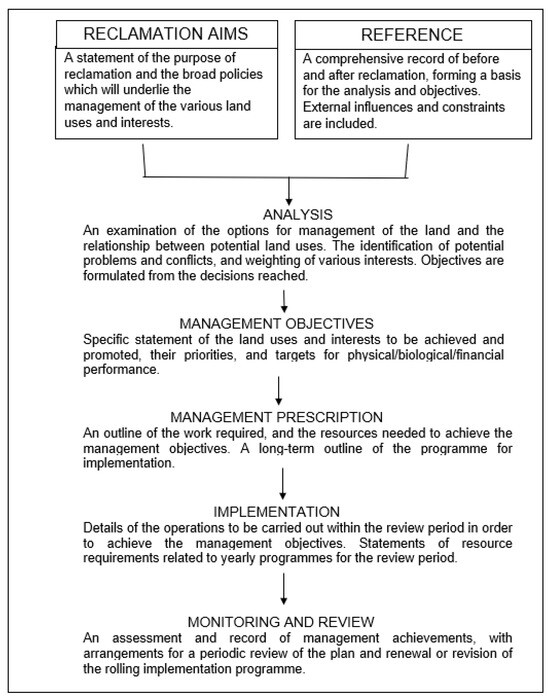
Figure 2.
The content and operation of a management plan (source: [24]).
4.2. Stabilisation and Vegetation Establishment on the Witwatersrand Mine Dumps
On the Witwatersrand, in South Africa’s Gauteng Province, gold mines extend from east of Johannesburg, following the gold reef that extends to the west and then to the south; where deeper mines are now also established into the Free State (Figure 1). Tailings were deposited from gold mines in sand dumps and slime dams throughout this region. This created a problem as wind-blown dust blew off the loose tailings into the city of Johannesburg in the early 20th century. Thus, the goal was to stabilise the tailings of sand dumps and slime dams so as to reduce sand-particle movement and production of dust (Figure 3a) [25,26]. In addition, acidic runoff from the tailings resulted in the pollution of rivers.
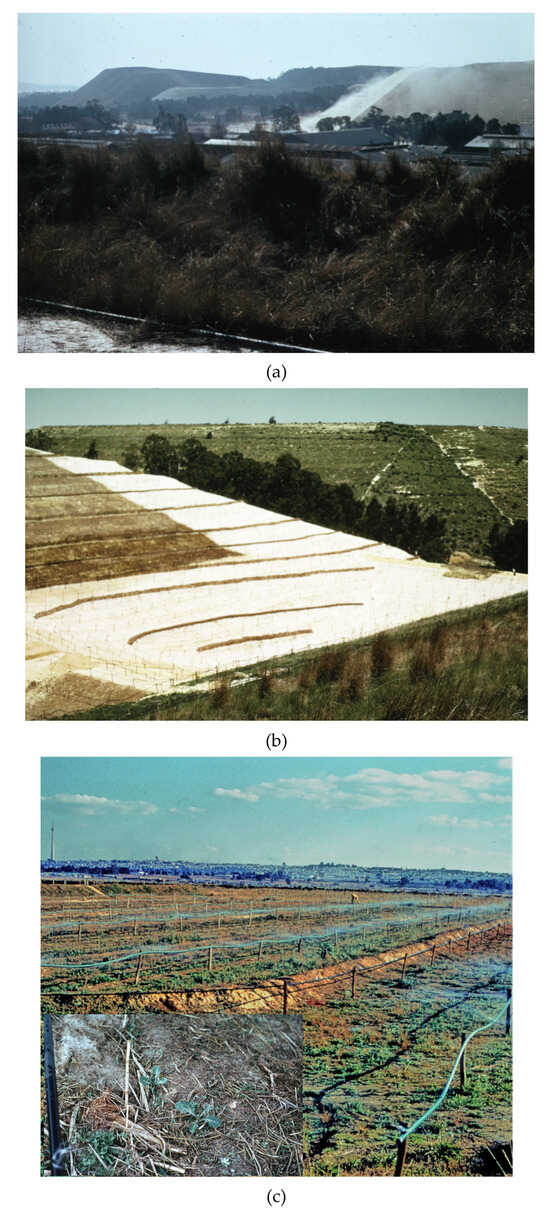
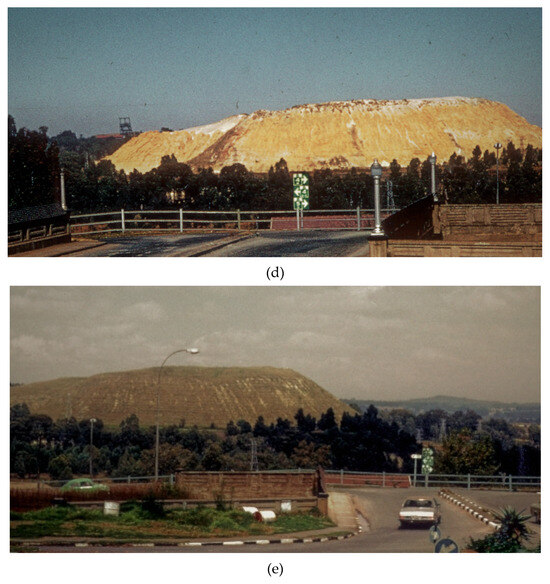
Figure 3.
(a). Sand blowing off an unstabilised sand dump in Johannesburg, 1974. (b). Stabilised tailing slime dams on the Witwatersrand using mainly introduced European species (Table 1). Paddocks are laid out with irrigation pipes and the surfaces seeded with the grasses. In the foreground, grasses are well established. In the mid-distance, the spoils are being prepared for seeding. In the distance, a dump has been stabilised previously and the grasses are thriving. Photos taken in 1974. (c). Irrigation of the tailings surface not only provides water for germination and growth of the grasses and herbs, but also leaches the acidity from the slimes, the material on which vegetation becomes established. The application of a mulch provides organic matter for the grass cover as well as stabilises the surface of the slimes. Inset close-up of the seedlings, fertiliser and mulch. Photos taken in 1970. (d). A sand dump on the West Rand before stabilisation in 1970. (e). The photo taken in 1974 shows the same dump after stabilisation.
- The Objectives were to stabilise the tailings and prevent erosion of the tailings into rivers and the generation of dust.
- Methods: Stabilisation was achieved by first establishing paddocks of reeds to restrict wind-mediated tailing movement (Figure 3c). Then, the surface of the tailings was irrigated, lime and fertilisers were added, and the site was planted with a “cocktail” of commercially available introduced grass and legume seeds. The whole “rehabilitation” process involved establishing vegetation on the dumps or revegetation of the land on which the tailings were deposited. In an early unpublished report by the Manager of the Vegetation Unit (Chamber of Mines), Cook [27] states that seeds eventually selected for sowing on the dumps were “New Zealand Brown Top, Rescue Grass, Rhodes Grass, Cocksfoot, Weeping Love Grass, Yorkshire Fog, Kentucky Blue, Fescue Type 31, Canary Grass, Clovers (2 varieties), and Lucerne”.
- Results: The end result was the outcome seen today with numerous stabilised slime dams and sand dumps throughout the Witwatersrand region (Figure 3b,d,e).
- Discussion: James [28] produced an early history of mine-dump stabilisation and Grange [25] expanded upon the problems of the tailing acidity and wind-borne dust in Johannesburg. Thatcher [26] summarised the process and extended the classification of the different mine dump types. She evaluated the success of the process and listed the grasses that were sown, mostly pasture grasses from Europe as seeds were readily available (Table 1). Thatcher [26] performed a quantitative analysis of the vegetation on a number of slime dams to evaluate the temporal changes in the vegetation. One notable feature was the invasion of indigenous species from outside propagule sources, thereby providing a more natural composition of grasses and herbaceous vegetation similar to the surrounding veld type or grassland (Figure 3b). A common early invader of grass species from the natural veld was thatching grass, Hyparrhenia hirta (L.) Stapf. In only rare instances, the climax grass species rooigras, Themeda triandra Forssk., was recorded.
 Table 1. Grasses that were sown in the initial stages of mine dump stabilisation on the Witwatersrand. The species are mostly pasture grasses from Europe, as seeds were readily available (source: [26]; originally supplied by Vegetation Unit, Chamber of Mines, Johannesburg).
Table 1. Grasses that were sown in the initial stages of mine dump stabilisation on the Witwatersrand. The species are mostly pasture grasses from Europe, as seeds were readily available (source: [26]; originally supplied by Vegetation Unit, Chamber of Mines, Johannesburg). - Concluding remarks: Stabilisation of the mine dumps was one of very few “restoration” projects established as early as the 1930s and has been little studied scientifically. Thus, our quantitative work as recorded by Thatcher [26] was of importance. Prior to that, only James [28] and Grange [25] provided descriptive accounts of the approach to stabilisation of the Witwatersrand mine dumps.
4.3. Stabilisation of Coastal Dunefields
The Cape Flats were difficult to traverse in the late 19th century and required stabilisation to allow easy movement by wagons along the sandy roads in the region.
- The Objectives were to stabilise the drift sands to make the roads easier to travel. The introduced marram grass (Ammophila arenaria (L.) Link) was viewed as a major asset to use in stabilising drift sands in many situations where the drift sands were problematic.
- Methods: Introduction of marram grass from Europe (Figure 4) was important to this process and no indigenous species performed better in the initial stages of reduction of sand movement [29,30,31]. Marram grass is ideal as it does not require irrigation for establishment in winter rainfall areas of the Cape and is easily planted from tufts collected from established colonies.
- The Results were that the drift sands were stabilised by the planted marram grass. The rhizomes of the grass grow upwards as dune sands are deposited, thus ensuring its success as a stabiliser of massive dune sand deposits. Marram is replaced by shrubs in the successional process (Figure 4), or the grass may just disappear as sands are stabilised. This is in contrast to situations where marram is invasive, such as in New Zealand [32] or on the Pacific Coastal Dunes of the USA.
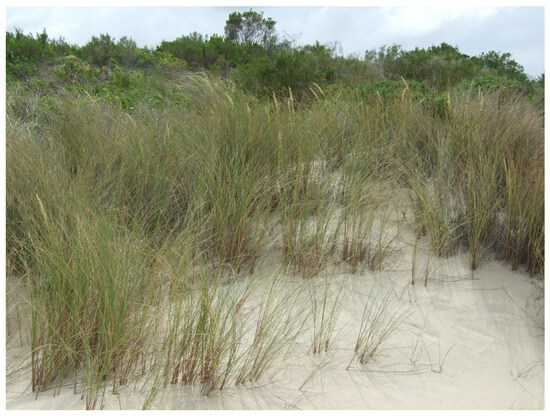
Figure 4.
Ammophila arenaria (marram grass) growing on dunes at Oyster Bay, and it is being replaced by shrubs with Coastal Scrub in the distance. Marram grass was originally introduced to stabilise sands on the Cape flats.
In stabilisation projects, such as a recent project at Hout Bay, Cape Town [33], marram grass is routinely planted on dunes, sometimes in paddocks (Figure 5). Marram grass was originally planted to stabilise the area surrounding Koeberg Nuclear Power Station, on the Western Cape coast and plants may still be found there (Figure 6).

Figure 5.
Marram grass (Ammophila arenaria) planted in 2017 at the Hout Bay stabilisation site, Western Cape, to prevent sand from blowing onto the car park at the harbour (photo: Ted Avis). This project [33] won the South African Landscapers Institute’s (SALI 2020) top award for excellence in landscaping, out of more than 100 projects submitted.
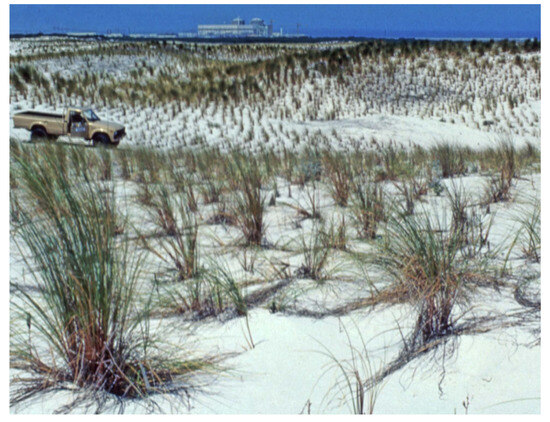
Figure 6.
The area surrounding the Koeberg Nuclear Power Plant, on the Western Cape shores, where marram plants may still be obtained.
In the restoration and stabilisation programmes along the Eastern Cape coast, different combinations of grasses were used as pioneer plants at different sites. Of the grasses recorded for the region, a number are indigenous pioneer grass species (Table 2).
- Discussion: There is no need to irrigate the planted marram grass as the winter rains of the Cape region are sufficient for its establishment; however, being an obligatory winter-rainfall plant, marram is only useful in the Cape. We found it used at Gonubie, near East London, but no farther east.
Marram grass co-existed naturally with indigenous species [9,34,35,36,37] and never became an exclusive dominant as it does on the North American Pacific Coast or on the shores of New Zealand. Knevel [38] and Hertling and Lubke [39] reported the presence of marram and indigenous species often as co-dominants in many sites in the Eastern Cape dune systems.

Table 2.
Grasses of the Eastern Cape dunefields (source [6,37]).
Table 2.
Grasses of the Eastern Cape dunefields (source [6,37]).
| Common Name | Genus Number | Scientific Name | Locality on Dunes |
|---|---|---|---|
| Pypgras, Pipe grass | Ehrharta villosa J.H.Schult. var. villosa | Pioneer on rear or foredunes | |
| Cotton-wool grass | 037 | Imperata cylindrica (L.) Raeusch. | Pioneer in wet slacks |
| Narrow-leaved turpentine grass, Muskusgras | 072 | Cymbopogon marginatus (Steud.) Stapf ex Burtt Davy | Climax grass or scrub |
| Finger grass | 089 | Digitaria eriantha Steud. | Climax grass or scrub |
| Coastal buffalo grass | 108 | Stenotaphrum secundatum (Walter) Kuntze | Pioneer in dune slacks |
| Reed panicum, Rietbuffelgras | 116 | Panicum deustum Thunb. | Climax scrub |
| Bosbuffelgras | Panicum aequinerve Nees | Climax scrub | |
| 205 | Pentaschistis heptamera (Nees) Steud. | Pioneer on rear dunes | |
| Marram grass | 256 | Ammophila arenaria (L.) Link. | Pioneer |
| Rat’s tail grass | 283 | Sporobolus africanus (Poir.) Robyns & Tourn. | Climax grass or scrub |
| Dunekweek Brakgras | Sporobolus virginicus (L.) Kunth | Pioneer of foredunes and dune slacks | |
| Heart-seed love grass | 286 | Eragrostis capensis (Thunb.) Trin. | Climax grass or scrub |
| Narrow heart-seed love grass | Eragrostis racemosa (Thunb.) Steud. | Climax grass or scrub | |
| Brown Rhodes Grass | 302 | Eustachys paspaloides (Vahl) Lanza & Mattei | Climax grass or scrub |
| Durban grass | 332 | Dactyloctenium australe Steud. | Climax grass or scrub |
| Seawheat | 434 | Agropyron distichum (Thunb.) P.Beauv. | Pioneer on foredunes closest to high-water mark |
In New Zealand, Hilton and co-workers [32,40] found that rhizomes of marram grass could be transported in the ocean, thus dispersing the species around the coast. Similar studies that we conducted on submerging marram for a time in sea water found them to be non-viable when planted out.
- Conclusions: From our studies, we can conclude that marram grass is a non-invasive species that can be successfully used in dune stabilisation should an assessment indicate that stabilisation of the dune system is required [10,36,37].
4.4. Revegetation, Replacement or Reclamation
Revegetation involves growing any vegetation on the disturbed site. It may be important when one wishes to quickly establish vegetation to establish a stabilising plant cover. Grasses are often successful in this respect, as on the Witwatersrand mine spoil heaps, and seeds of pasture grasses are often readily available.
Replacement is purposely growing certain plants different to the original vegetation cover, possibly to provide an alternative land use.
Example 1 of Replacement: Butchart Gardens were established in a disused lime quarry in the 19th century near Victoria on Vancouver Island, B.C., Canada. The Butchart family had mined the site for many years and a derelict site of former forest communities resulted.
Objectives: To provide a use for the site that could serve as an attraction to locals and tourists on Vancouver Island.
Methods and Results: On closure of the quarry, Mrs Jennie Butchart originally planted plants on the former quarry walls while being supported in a bosun’s chair. Once the gardens were well established, they became a popular tourist attraction in the region (Figure 7).
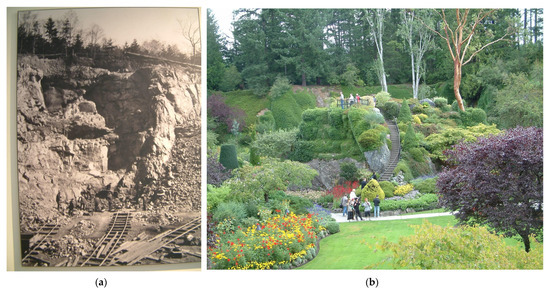
Figure 7.
The Butchart Gardens were established in a disused lime quarry in the 19th Century, near Victoria on Vancouver Island, B.C., Canada. (a). Working the quarry. (b). The gardens in 2000.
Discussion: Today, although still privately owned and operated, it is one of the most famous Botanical Gardens worldwide where the indigenous forest of the island has been replaced by exotic species, Italian-style gardens, fountains, ponds, and lakes, creating a superb Botanical Garden to visit [41].
Replacement is frequently overlooked but is often a logical option where land use is of paramount importance. Replacement and reclamation are often considered in tandem, as reclaiming land for a particular land use may require replacement with alternative plant types dissimilar to the original vegetation types.
The classic example of reclamation is that of land from the North Sea reclaimed for agriculture, which dates back many centuries. Replacement is similar but represents a situation where the previous vegetation may be replaced by an alternative land use. One needs to examine the needs of the local communities who will benefit from the rehabilitation in the region.
Example 2 of Replacement: CES have conducted many EIAs where heavy mineral mining was proposed in Mozambique. An important aspect of these studies is the rehabilitation of the mine tailings after mining ceases, e.g., [42].
Objectives: To consult with the local community and consider the best option for use of the mine tailings by the residents.
Methods and Results: At one mining site, the alternative land use is planting with cassava (Manihot esculenta Crantz) (Figure 8). Topsoil, taken from ahead of the mining operation, is spread on the mine tailings. The tailings are sterile but chemically benign, as the organic matter and nutrients have been removed. Cassava is a major commercial crop in Mozambique and grows very successfully in the local sandy soils with little cultivation effort. Grasses also fill the place of indigenous species (see Figure 8a,b).
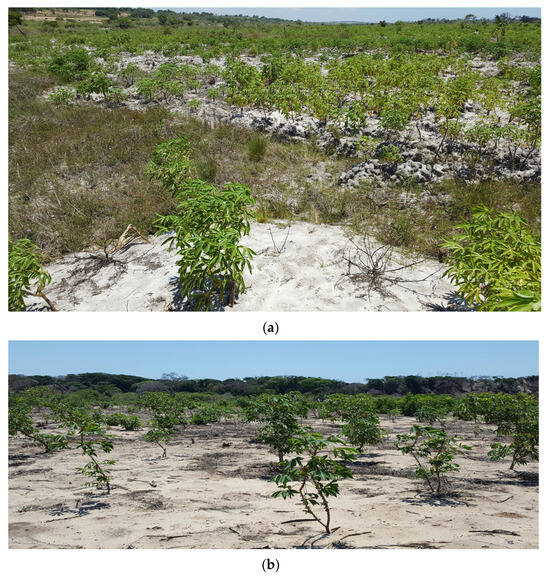
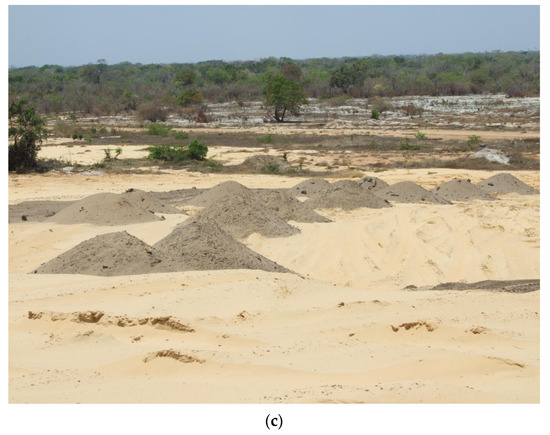
Figure 8.
(a). Cassava (Manihot esculenta) plants and grasses used as a replacement to fill the place of indigenous species. (b). An important alternative land use is planting with cassava plants, the major crop in Mozambique, as seen here near Moma. (c). The topsoil was added prior to planting.
Discussion: Replacement has been followed in mined areas where local communities have special agricultural requirements, rather than return the site to natural ecosystems. Moreover, the communities will often have already removed the indigenous vegetation for agriculture prior to mining.
Conclusion: Replacement is a logical option where land use is of paramount importance [42].
4.5. Plant Succession and Its Relationship to Restoration and Rehabilitation
There is often confusion involving the terms used in “Restoration “and these need to be clearly defined and explained.
Objectives: To explain the relationship among the terms used in this subject.
Methods: Diagrams and demonstrations by authorities are shown in this example.
Results: Bradshaw [2] pointed out that rehabilitation is on the trajectory to full restoration, or the original former state of the degraded site as shown in Figure 9. The relationship between succession and restoration is also shown in the diagram. Restoration may, in some cases, never be achieved.

Figure 9.
Bradshaw’s schematic illustration of the relationship between restoration and succession (source: [2]).
Professor Jim Harris [43] at the 17th International Conference of the Society of Ecological Restoration in Zaragosa, Spain, pointed out that:
- Succession (S) is a natural change in species and ecosystems over time.
- Restoration (R) is a goal that is the manipulation of succession to produce a desired condition (Figure 10).
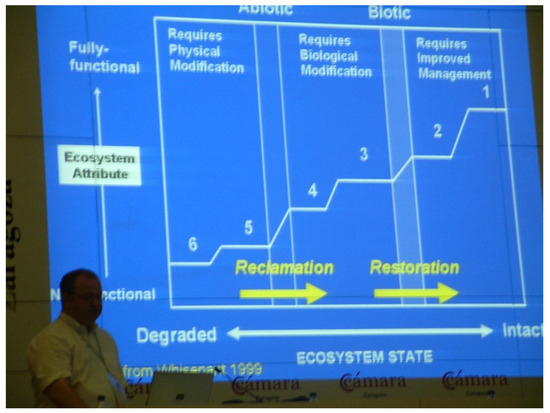 Figure 10. Professor Jim Harris at the 17th International Conference of the Society of Ecological Restoration in Zaragosa, Northern Spain, 2005. He explains the different stages of restoration in this slide (see [43]).
Figure 10. Professor Jim Harris at the 17th International Conference of the Society of Ecological Restoration in Zaragosa, Northern Spain, 2005. He explains the different stages of restoration in this slide (see [43]).
Discussion and Conclusion: Harris further emphasised that restoration and succession are not linked adequately. Thus, it is important to note that to study natural succession as restoration without succession is like driving without a license. Furthermore, he concluded that restoration is to succession, as engineering is to physics; see [44].
4.6. Successional Studies on Eastern Cape Dunefields
The Eastern Cape coast consists of extensive mobile dune systems, many of which are not colonised by vegetation except for dune scrub species that occur well above the high-tide mark [5]. Because of the remarkably diverse habitats, there are numerous plant communities that stabilise the dunes and extend into the climax thicket and grassland vegetation types [45].
Objectives: To analyse the situation of successional change on the dunefields and define the changes that occur from the pioneers through to the climax vegetation. In addition, to identify the pioneer species and the role of grasses in the process.
Methods: Lubke and Avis [6] sampled quadrats in the dune field from the pioneers through to the climax dune thicket. The authors recorded changes in the soil properties and also made experimental studies on the effects of the climate on some plant species.
Results: Lubke and Avis [6] proposed a successional progression from the pioneer communities, which have a low density and low diversity of plants, towards a more diverse and dense climax community for the dunefields of the Eastern Cape coast (Figure 11).
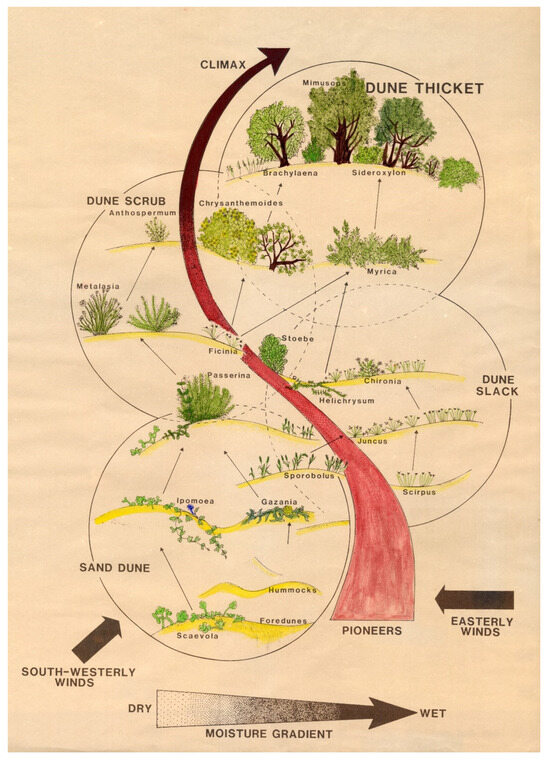
Figure 11.
The successional process on Eastern Cape sand dunes and dune slacks. (source [6]).
A list of the grasses for this coastal region of the Eastern Cape, from Port Alfred to the Fish River mouth, shows that six of the sixteen species are pioneer species at various stages in the dune succession (Table 2), three occur on the foredunes, three grow in the dune slacks, and two grow on the rear dunes. More than 10 of the species listed in Table 2 are found in climax grasslands or in forested areas.
In this situation at the Fish River mouth (Figure 12), the pioneer grasses are dunekweek or brakgras (Sporobolus virginicus (L.) Kunth), pypgras (Ehrharta villosa Schult.f.), and marram grass. Subclimax shrubs also present in the photos are waxberry (Morella cordifolia (L.) Killick), dune everlasting (Helichrysum sp.), blombos (Metalasia muricata (L.) D.Don.), and slangbos (Stoebe plumosa (L.) Thunb.). It is unlikely that any climax vegetation will develop in this situation because of human trampling and periodic flooding during high spring tides, especially if accompanied by storm events. Thus, the succession at this site will be a recurring event.
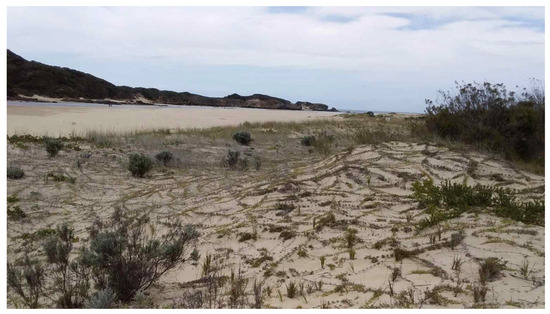
Figure 12.
The banks of the river at Fish River mouth, Eastern Cape. Here, the pioneer grasses are dunekweek (Sporobolus virginicus), pypgras (Ehrharta villosa), and marram grass (Ammophila arenaria).
Discussion: This succession on the dunefields is thought to follow the Clementsian or facilitation model of succession [46,47], as reviewed by Avis [8], Avis and Lubke [37] and Lubke [45], who described dunefield communities along the southeastern coasts of Africa. Communities change from sand dunes and dune slacks through dune scrub to dune thicket. We observed the vegetation in many sites along the Eastern Cape coast at different states of succession [6,8,30,45].
Lubke and Avis [48,49,50] also investigated environmental factors, such as wind blasting and salt spray, and how these factors affect the distribution of dune plants. Experimental studies were conducted in the greenhouse [49], and then these experimental studies were extended to observations and measurements of the effects in the natural dune and dune slack positions [48,50]. The adaptability of Ficinia nodosa (Rottb.) Goetgh., Muasya et D.A. Simpson (=Scirpus nodosus Rottb.) (Cyperaceae) was monitored and was found to be adversely affected, by salt spray and sand blasting especially, on the exposed dunes, but less so in the lee of the protected dune slacks.
Connell and Slatyer [47] examined the successional process and defined various models of succession. The individualistic successional model, as defined by these authors [47], was proposed by Lubke and Avis [6] for the succession on the coastal dunes (Figure 11) that suggests community change passes from either pioneer foredunes, or dune slack, through dune scrub to dune thicket. Under the prevailing climatic conditions, the climax vegetation of coastal scrub or thicket in the Eastern Cape will never be reached [6]. During moist conditions, the foredune and dune slack communities may become well established, but during subsequent dry periods these communities will either die or will be buried by moving sand. Only if rainfall increases and becomes more consistent will the dune-field vegetation develop beyond the existing pioneer communities on the foredunes and vegetated dune slacks with isolated bush pockets in the extensive dunefields. Under a higher moisture regime, the result may be more extensive dune thicket or even dune forests, such as in KwaZulu-Natal [8].
Conclusions: Although it is not necessary to understand the succession process in as much detail as we have described for Eastern Cape coastal dunefields, it is important to know the succession process in the natural ecosystems, where the rehabilitation is to be implemented, as restoration often mimics natural succession (Figure 9).
4.7. Successional Studies on Other Coastal Dune Systems in South Africa
Tinley [51] presented a sequential assessment of dune communities and dune vegetation dynamics along the entire southern African coastline. The most notable site for a complete succession on prograding dunes was in the Mtunzini dunefields in KwaZulu-Natal. In two noteworthy papers, Weisser and Marques [52] and Weisser [53] documented this perfect model of the succession of prograding dunes with pioneer plants to coastal forest.
Objectives: We extended our dune studies of succession from the Eastern Cape to KwaZulu-Natal.
Methods: Over a number of days, we sampled the different sites at Mtunzini, from the high-tide mark through to the coastal forests, with sample sites in all stages of succession.
Results and Discussion: This static model was analysed quantitatively, and we could clearly show how the pioneer grasses and shrubs were replaced by secondary species and the climax forest species of the region [8].
Conclusions: The pioneer grasses and shrubs were replaced by secondary species finally resulting in the climax forest as found in the region.
4.8. Restoration after Dune Mining
In the 1980s, Richards Bay Minerals (RBM) proposed mining on the Eastern Shores of Lake St Lucia where the company had been prospecting for heavy metals for some years [54]. On the strength of our studies on dune systems, and since we had already assessed the current rehabilitation of dune forests after mining at Richards Bay (Figure 13 and Figure 14), we [54] were appointed to execute an EIA for the proposed mining project.

Figure 13.
A 23-year-old rehabilitated Acacia kosiensis Woodland at Richards Bay which was the result of a complex rehabilitation plan implemented by RBM. This was an early woody stage of vegetation that would ultimately result in a climax Coastal Forest. Even at this stage, in September 2003, one can see the invasion of other species such as the Wild date palm (Phoenix reclinata) and the Natal wild banana (Strelitzia natalensis).
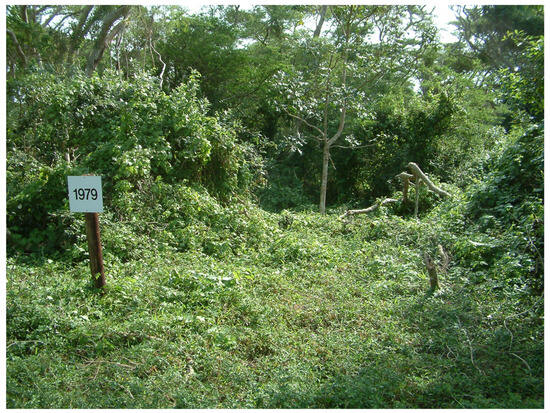
Figure 14.
A more mature coastal forest, one of the oldest sites of rehabilitation in the Richards Bay area, following dune mining. This photo was taken in 2003, and the rehabilitation site dates to 1979.
Objectives: To show the possibilities of restoring the natural vegetation following dune mining at Richards Bay.
Methods: We sampled all the vegetation sites in 10 m2 quadrats, where RBM had rehabilitated the vegetation following dune mining, and performed a quantitative analysis of the data set [54]. This would provide an approximation of what could be achieved at St Lucia.
Results: The results showed that the return of natural coastal forest (Figure 14) was indeed possible and that recreation of grasslands was achievable (Figure 15).
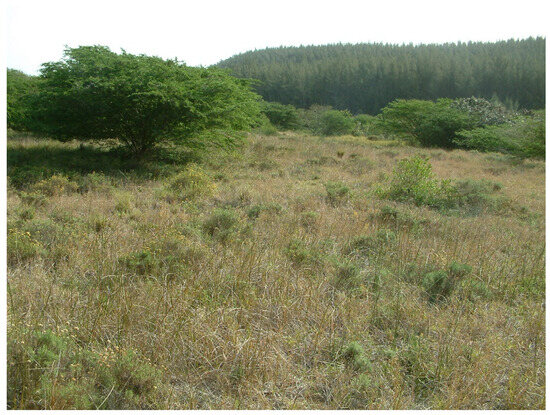
Figure 15.
Restored grassland at Richards Bay after rehabilitation by Richards Bay Minerals, Photo of September 2003.
Discussion: RBM believed that the most important aspect of such an EIA study on the Eastern Shores of St Lucia was the rehabilitation plan. However, the EIA became a massive undertaking and resulted in our establishing of an environmental advisory company (CES). The project lasted 3 years and resulted in a resounding rejection to mining of the Eastern Shores because of the cultural importance of the region to many people using the St Lucia area over many years ([23]).
Conclusions: The impact study on the Eastern Shores involved a detailed study of the vegetation in order to assess the successional processes, especially after the clearing of the coastal forest for grasslands [54].
4.9. An Example of a Project: Setting Aims and Project Execution
CES has conducted more than 10 EIAs in eastern and southern Africa (and one in Egypt) particularly with respect to proposed dune mining for heavy minerals. These projects were all approved resulting in the establishment of a new mine in Mozambique, one in Kenya and one in Egypt.
Objectives: The aim of this section is to show how an EIA is executed with the objective of determining if the proposal may go ahead, with or without mitigating measures, and to advise as to how the rehabilitation is to be conducted.
Methodology: In the following example of an EIA conducted for RBM or other mining companies in east Africa, the process or methodology is described in some detail under separate headings.
- The EIA
The goal of the EIA is, first, to investigate if there is any fatal flaw in the proposed mining, for example, the mine path is located within the distribution area of a rare or endangered species, the proposed mining is situated too close to endangered habitats such as estuaries, there is a lack of water or infrastructure for the mining to proceed, or there is a shortage of skilled labour.
The EIA will examine all aspects of the natural and socio-economic environments, and the impact that the mining may have on the flora, fauna or the well-being of any other organisms and the residential communities of the region. The impacts will be individually examined as to the bearing on each of the biota, the ecosystems as a whole and whether it is possible to mitigate against the impact should the mining or adverse activity, such as transportation of the supplies or mining products, proceed. Consultation with the local community and others who may be affected by the activities is an important process in itself.
Production of the EIA requires the input of specialists in the different fields and experienced environmental consultants to synthesise the results and present them in a meaningful way.
- The Reports
The reports of the EIA take the form of individual specialist reports, e.g., the assessment of the flora and vegetation at Richards Bay, KwaZulu-Natal, which were conducted by CES, specifically Lubke et al. [23]. Once all of these reports are produced, a study of the proposed rehabilitation of the tailings and the site after mining can be formulated [23]. In this example, the volume containing the specialists’ reports alone was 741 pages.
- The Decision Making
The reports are presented to the public at a public meeting and are accessible at a common site, such as the local library, for a number of weeks for scrutiny, appeal, and submission of documents to the authorities. The authorities in charge of the activity, local or national government mining departments in this case, are responsible for making the decision and may set various provisos or conditions required for the activity to proceed.
- Rehabilitation Report
The report must clearly state the aims of the rehabilitation programme, as discussed in this paper, and the means of mitigation against adverse impacts where possible. The favourable outcomes of the proposal must also be clearly emphasised, such as increased employment and economic advancement for the local community. For example, the replacement of the disturbed or disrupted natural vegetation to cassava cultivation on the mine tailings was seen as a distinct advantage to the local communities in Moma, Mozambique (Figure 8b).
Results: The rehabilitation report will give detailed guidelines and recommendations. For example, at Corridor Sands (Gaza Province) Avis and Blood [42] recommended:
- Development of a detailed rehabilitation programme in consultation with representatives of the local community, prior to the start of mining, to define rehabilitation objectives that consider both the communities’ needs, and the constraints dictated by the post-mining landscape.
- Corridor Sands must provide a full-time on-site environmental officer.
- Field trials must be set up to help establish:
- what indigenous species should be re-established, such as the grass species to use in the rehabilitation of cultivated and disturbed areas (Table 3).
 Table 3. Potential indigenous grass species for rehabilitation of cultivated and disturbed (fallow land) areas using seed as a means of propagation [42].
Table 3. Potential indigenous grass species for rehabilitation of cultivated and disturbed (fallow land) areas using seed as a means of propagation [42]. - what suitable crops and new varieties of crops should be used in the rehabilitation programme.
The specific quantities of seeds (in kilograms per hectare) recommended for sowing in the area for rehabilitation are given in this example (Table 4). The suitability of these species will need to be determined through field trials, and the need to establish them assessed through consultation with the local community.

Table 4.
Grass species and amount of seed (kg/ha) to apply to rehabilitated areas [42].
The rehabilitation report, therefore, is an important document that should be used by the environmental advisers and the rehabilitation practitioners should the proposed activity proceed. However, too often these reports are not utilised and simply gather dust on the shelves.
Discussion and Conclusions: Dune mining is a particularly benign type of mining as minimal pollutants are generated and the tailings consist of the raw sand from which heavy minerals, which are not necessary for plant growth, have been removed. Thus, the process entails reapplying the topsoil, which was removed prior to mining, to the tailings and planting the preferred vegetation cover for rehabilitation.
One needs to look at the current land use before formulating a rehabilitation plan. Goals are established compatible with a management plan (Figure 2). The report (for example, [42]) may contain a conceptual rehabilitation model for the proposed mining site.
5. General Discussion and Conclusions
5.1. Establishing a Rehabilitation Programme
Before a restoration programme is prepared, one needs to examine the current land use. Then goals can be devised to meet the needs of the local community. This can be included within a management plan as shown in Figure 2. Apfelbaum and Haney [55] discuss their ‘Ten-Step Approach to Ecological Restoration’, which is essentially the same approach that we have outlined in Figure 2. The authors emphasise the importance of formulating objectives, reviewing the landscape to be restored, and the importance of monitoring and feedback.
5.2. Stabilisation and Vegetation Establishment on the Witwatersrand Mine Dumps
In 1932, Professor John Phillips, Professor of Botany at the University of the Witwatersrand, gathered information on attempts to establish vegetation on mine dumps. He conducted further experiments and quickly concluded that the problem with the establishment of vegetation on the tailings was the acidity that develops on the oxidation of the pyrites. Grange [25] provides an account of this process and the associated problems. He elaborates that, by 1953, the problem of stabilising dump surfaces had not been solved. The Chamber of Mines, together with the Council for Scientific and Industrial Research, investigated the structural stability of slime dams. The Steering Committee responsible for the project recommended that the best method of stabilising the dump surfaces would be to establish vegetation on them if this could be achieved.
The recorded experimental studies performed on individual mines, such as Luipaardsvlei, near Krugersdorp, was the work of the mine manager of Luipaardsvlei Gold Mine, Mr D. Chenik, assisted by a consulting metallurgist, Mr H.E. Cross, and the mine group’s horticulturist, Mr W.H. Cook. These individuals produced the first information on the problems in the establishment of vegetation on the mine dumps. The results of some early trials were recorded by Chenik [56].
Mr Bill Cook, the manager of the Vegetation Unit of the Chamber of Mines, subsequently led the Vegetation Programme on the residual mine tips for many years. In the 1970s, Groves [57] was appointed manager for some years, but few advances on the already-established techniques were achieved.
More recently, Kneen et al. [58] re-examined the dust pollution in Johannesburg in relation to the sprawling mine dumps in the city. The authors documented residential development from 1952 to 2011 (using historical aerial photographs, census data from 2001 and 2011, and ancillary information) to determine the population exposed to dust emanations from the tailing storage facilities.
One can conclude, for the mine dumps of the Witwatersrand, that:
- Stabilisation of tailings is often necessary to prevent migration into adjacent areas or the loss of tailings as dust (Figure 3a).
- It is important to create an aesthetically pleasant environment, so the establishment of vegetation on tailings in the area of disturbance is the best option.
- It is important to acquire a thorough knowledge of the properties of the tailings, as soil is important for the growth of the plants. Grange [25] and Thatcher [26] reported on the change in the tailings to a soil-like medium.
- It may be especially important to choose plants that are suitable for the particular soil conditions of the tailings. This is the approach that has been supported by Bradshaw [2] and his colleagues [59,60] in the UK, where they have identified tolerant races of plants and used them in stabilisation of tailings. Similarly, this approach has been followed in Zimbabwe [61], and the Witwatersrand approach has been criticised for not adopting this approach.
Only recently have Weiersbye and Witkowski [62], working at the University of the Witwatersrand, adopted an innovative approach to research into growth of vegetation on the Witwatersrand mine dumps. This exciting new approach to the problem has considerable potential [63]. The authors have also examined the drift of mine-tip residual particles into the atmosphere and conducted a risk assessment on this problem [64].
However, the techniques were little changed for many years until the reworking of many tailing dumps for gold extraction (Figure 16a). The mining of the Witwatersrand for gold, which dates back to 1885, has resulted in 6 billion tons of tailing materials in sand dumps and slime dams. Given historical processing inefficiencies, these tailings are currently being remined as a secondary gold source. This has resulted in the production of megadumps in the south of the city. It was subsequently found that installing sufficient drainage systems and armouring the surfaces with course rocks and boulders were advantageous for establishing satisfactory grass cover (Figure 16c).

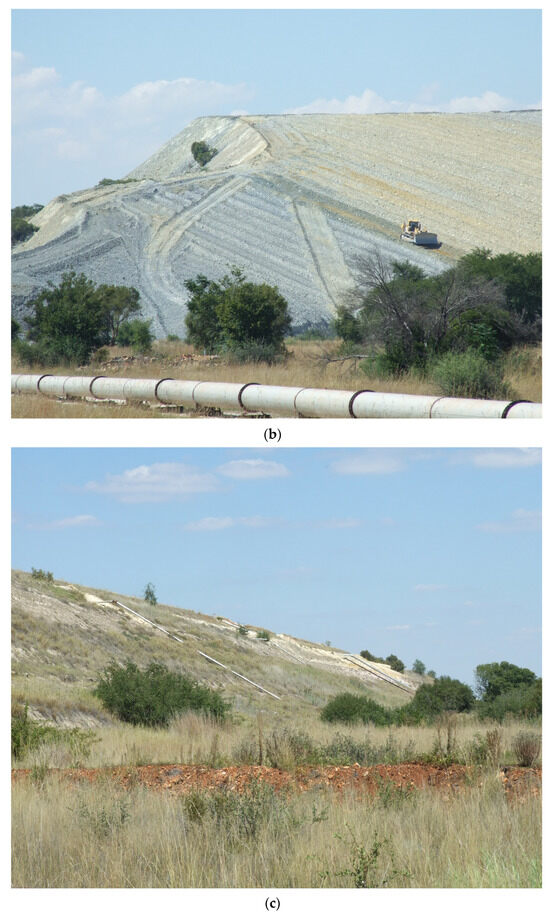
Figure 16.
(a). Poster by AngloGold Ergo illustrating the formation of the new mega dumps and rehabilitation with grass cover. The poster was presented at the Mine Closure Conference, Johannesburg, January 2014. (b). A mega dump, constructed in the southeast of Johannesburg. January 2014. (c). A mega dump that is been stabilised with grasses, and with concrete and pipe drainage fitted to prevent erosion (photographed on an excursion during the Mine Closure Conference, Johannesburg, January 2014).
The Top Star Drive-in, established in the 1960s, sat on the flat surface of a dump on the south-eastern side of Johannesburg and provided a spectacular panoramic view of the city. A tarmac road wound to the drive-in site, a scene of many midnight movies and parties that many old-timers wished to preserve. Heritage organisations sought to stop DRD Gold from flattening the dump and reworking the material. The dump was declared a provisional heritage site, but DRD Gold appealed the decision and was determined to go ahead with reprocessing plans [65]. There is a need to consider if the final land use is of benefit to the community, especially conservation of the previous environment if it is of cultural or historical value.
There has been much discussion recently on the illegal reworking of the old mines, and the legality and laws that have been introduced to control both the illegal mining and the disposal of the spoil in the past. These aspects have all been well reviewed by Mabaso [66] and are beyond the scope of the present review of rehabilitation.
5.3. Mine Dump Studies in Limpopo Province
Mulugisi et al. [67] conducted a study on the mine dumps of Limpopo and suggested that using local indigenous grass species for mine dump rehabilitation is both environmentally friendly and cheaper. Furthermore, it is attractive to use local plants, which are adaptable to local climatic conditions and are able to thrive under the adverse conditions that are prevalent at these sites. Four grass species were analysed for their uptake of heavy metals, namely, Cynodon dactylon (L.) Pers., Hyparrhenia timba (Hochst. ex Steud.) Andersson ex Stapf, Hyparrhenia hirta and Paspalum dilatatum Poir., and the sedge Cyperus esculentus L.
5.4. Revegetation, Replacement or Reclamation
There are few examples of replacement in the latest literature, as restoration or rewilding are the techniques now deemed to be most important. The following examples are accessible in the recent literature.
Example 1: An unusual situation of ecological replacement as a restoration tool was reported with respect to animal species in Mauritius and the Indian Ocean. In my view this is ecological species replacement, as opposed to the replacement of an ecosystem type with an alternative, such as crops. Moorhouse-Gann [68] notes that species extinctions on islands are commonplace, which may lead to dysfunctional ecosystems, especially when keystone species are lost. She expands upon the introduction of an analogue species to restore ecosystem function (known as ecological replacement). In Mauritius, exotic giant tortoises (Aldabrachelys gigantea (Schweigger, 1812)) have been introduced to the island from the islands of the Aldabra Atoll in the Seychelles, to restore ecosystem function. The species endemic to the island were hunted to extinction by early seafarers looking for fresh meat on the island. These tortoises were thought to be keystone grazers. Moreover, dietary analysis is essential to understand the impact that tortoises have on the ecology, so metabarcoding of plant DNA from faecal samples of the introduced tortoises was conducted to recover detailed dietary information. The aim of the study was to use DNA metabarcoding to assess the impacts and interactions of introduced Aldabra giant tortoises on Mauritius undergoing restoration. Giant tortoise grazing alters the plant community structure by cropping both exotic and native vegetation. Thus, the engineering of the vegetation structure shows how tortoises create and maintain tortoise lawns, which together with the established forested areas forms a vegetation mosaic that may be beneficial for biodiversity of all species in the ecosystem.
Example 2: A comparable situation of loss of a keystone species is hypothesised to be that of the dodo on Mauritius. Here, a species similar to the South African milkwood (Sideroxylon inerme L.), named Sideroxylon grandiflorum A.DC. (commonly called tambalacoque) is endemic to the island and in danger of extinction. This species has a fruit called a drupe, with a hard endocarp, or pit, surrounding the seed. Temple [69] hypothesised that the dodo, which became extinct in the 17th century, ate tambalacoque fruit, and by passing through the digestive tract of the dodo, the endocarp was digested and then the seeds could germinate. He force-fed 17 tambalacoque fruit to wild turkeys.
- Seven of the fruit were crushed by the bird’s gizzard.
- Ten were either regurgitated or passed with the bird’s faeces. Temple planted these ten fruit and three germinated.
- Temple did not try to germinate any seeds from control fruit not fed to turkeys, so the effect of feeding fruit to turkeys was unclear.
Temple’s hypothesis that the tree required the dodo for seed germination was contested because of the lack of a control. Moreover, it was pointed out that other extinct animals may also have been distributing the seeds, such as giant tortoises, fruit bats or the broad-billed parrot (e.g., Witmer and Clarke [70] review this hypothesis, which is called obligate mutualism).
Example 3: Ranjan et al. [71] found that for stabilisation of the slopes of mine tips, the use of indigenous species was the best approach rather than ecological species replacement. Their study explored the potential of using local, rather than exotic, species to provide mechanical stability of the waste dump resulting from a surface iron ore mine. The authors hypothesised that commonly available local species are likely to fit into the ecosystem and adapt quickly to the climate, and thus were used for vegetation on the waste dump. The result was that the mechanical stability of the waste dump was significantly improved with the application of local species. Thus, ecological species replacement is not always the best alternative.
5.5. Plant Succession and Its Relationship to Restoration and Rehabilitation
Drury and Nisbet [72] noted that a common feature of the then-contemporary successional theories (i.e., before 1973) was that succession was attributed to properties of the community. The authors stated that the Odum–Whittaker hypothesis was unacceptable as a generalisation and that succession was the result of certain adaptive strategies being mutually exclusive. For example, species whose seeds are dispersed over long distances and that grow rapidly in harsh conditions cannot also develop to a large size and be long-lived. These problems and shortfalls in successional theory led to the Connell and Slatyer [47] models, and data collected on dunefields support the Facilitation Model. There are also a number of other studies that support these models. Olson [73] presented evidence for an autogenic succession on the Lake Michigan sand dunes, and he showed that two Connell and Slatyer models (mechanisms vide Picket et al. [74]) play a role in this succession. Initially succession was by the pioneer grass Ammophila breviligulata becoming established on foredunes, facilitating the establishment of oak communities, but succession is primarily allogenic in later stages when the climax oaks are self-perpetuating in acidic soils.
There is considerable evidence for the development of soils in relation to vegetational succession. Salisbury [75] reported that changes in organic content, pH and leaching of carbonates were accompanied by changes in the flora. Olson [73] reported on the dune succession at Lake Michigan, where it was only once autogenic changes to the microenvironment and soil occurred that woody species were able to invade. Smith et al. [76] described a successional sequence from bare, unconsolidated sand to a forested well-developed soil in New Zealand. With increasing distance from the sea, the vegetation stature and complexity increased. Similarly, soil profiles showed an increasing number of horizons, accumulation of organic matter at the surface and in mineral horizons, changes to redder hues in the B and C horizons, and textures were extremely loamy. It is apparent that increase in plant biomass with time has led to organic matter accumulation and establishment of a deep organic cycle which, with leaching, have been the major soil-forming processes operating in the development of the soil sequence [75].
5.6. Successional Studies on Eastern Cape Dunefields
In the seaward-facing communities where succession is known to be occurring [6], successional stages in pedogenesis can also be observed. As the vegetation changes from foredune pioneers to bush clumps to thicket margin and finally coastal thicket, there are associated changes in the soil: the organic matter content, percentage moisture and conductivity all increase with a slight decrease in ph. High organic matter content, percentage moisture and conductivity are an indication of a better-developed soil. The foredune soils that contain little organic matter, low percentage moisture and have low conductivity are less developed. This can also be seen in the structure of the soils; the foredune soils are sandier and the better-developed thicket soils are more loamy [8].
In the different communities of the fixed dunes (i.e., grassland, bush clump, thicket, and thicket margin), the characteristics of the soils are also closely related to the vegetation present. However, as for the vegetation, this may be successional, or it may simply be a result of the position of the different communities as one moves from the sea inland.
5.7. Rehabilitation after Dune Mining at Richards Bay
The news of the controversial EIA at St Lucia and our studies resulted in numerous additional studies on, and critiques of, the RBM rehabilitation techniques (e.g., by Mentis and Ellery [76]. Of particular use to us were the studies by Everard and his colleagues [77,78,79], who assessed the type of secondary successional process to grasslands after forest clearance. We subsequently evaluated the potential for the re-establishment of grasslands after dune mining, as that would be the desired outcome [80]. This was a feasible and desirable outcome to restore the status quo following the proposed mining. However, this approach was not favourably received by RBM, which preferred the rehabilitation to coastal forest vegetation following mining. This was a complex restoration process that RBM had satisfactorily achieved (Figure 13 and Figure 14).
Van Aarde and his colleagues and students [81,82,83] subsequently established an extensive study of the rehabilitation process at RBM and the rehabilitation of many communities of animals into the coastal forests has been published. Some of these accounts are the consequence of the introduction of a rehabilitation programme to re-establish coastal forests rather than defining the aim of re-establishing colonies of ants and birds, for example. The successional process in these coastal forests has been reassessed [17] and Grainger and Van Aarde [84] concluded that Gleason’s individualistic model [85] is a valid successional model for the restoration of subtropical coastal dune forests [83]. Their study is based on an examination of the vegetation of recently stabised sites to the production of mature forests going back to 1979, when those mine sands were first rehabitated (see Figure 14).
In 2003, CES [86] were asked to assess the success of the RBM rehabilitation programme at Richards Bay, as the management was of the opinion that the rehabilitated lands could now be handed over to the local authorities. After a detailed study of the work that had been completed on the rehabilitation, we produced a report that also examined the broad aims of rehabilitation in the region. We proposed many other alternatives to the rehabilitation of coastal dune forest and were critical of their lack of concern for the reconstruction of grasslands that could be feasibly achieved (Figure 15). Moreover, the cattle of the local community continually invade the forests in search of forage (Figure 17). Because of our critique of the lack of applying aims to the rehabilitation and consideration of alternative land uses for the region, our reports were not favourably received [86].
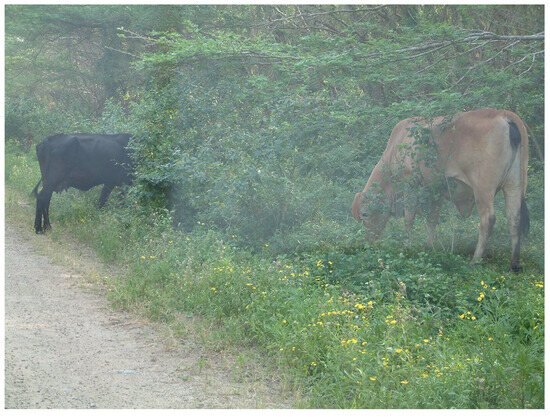
Figure 17.
Cattle grazing in the restored Coastal Dune Forests at Richards Bay, September 2003. RBM were set on restoration of Forests, rather than a replacement of grasslands for the local people to graze their cattle.
5.8. The New Wild: Why Invasive Species Will Be Nature’s Salvation
Pearce, an environmental journalist, in his recent book titled The New Wild [21], advocates a “do nothing” approach when alien species have invaded. He maintains that the invasive species are not spoiling pristine “natural” ecosystems but rather represent the changing face of the environment. “We humans have changed the face of the planet too much, and nature never goes backward.” He cites many examples from around the globe, but his premise is wrong that we cannot “re-engineer ecosystems.” Ecologists have shown that invasive alien species can be removed, and the natural systems restored. It is a long and slow process and can be very costly. Restoration ecologists can achieve success in most cases unless novel ecosystems have been created [22] and it is impossible to remove an obstacle in the path to recreate the natural system. According to the book-cover blurb, Pearce has quite some support, including James Lovelock [87], the author promoting the Gaia hypothesis.
Although Pearce [21] has researched his premise of allowing the invasive alien species to take over and create a “New Wild”, it is unlikely to be taken very seriously by restoration ecologists. It is an uphill battle to remove alien species, but it has been accomplished on certain smaller islands of New Zealand [88].
In Northern California, Andrea Pickart and her coworkers [88] have reported on the attractive flora of the region and how the introduction of European beach grass (Marram grass) has spoiled the dune environment (Figure 18a). Within the reserve areas, they have been able to clear the invasive species and restore the native flora as is shown in these photographs (Figure 18b).
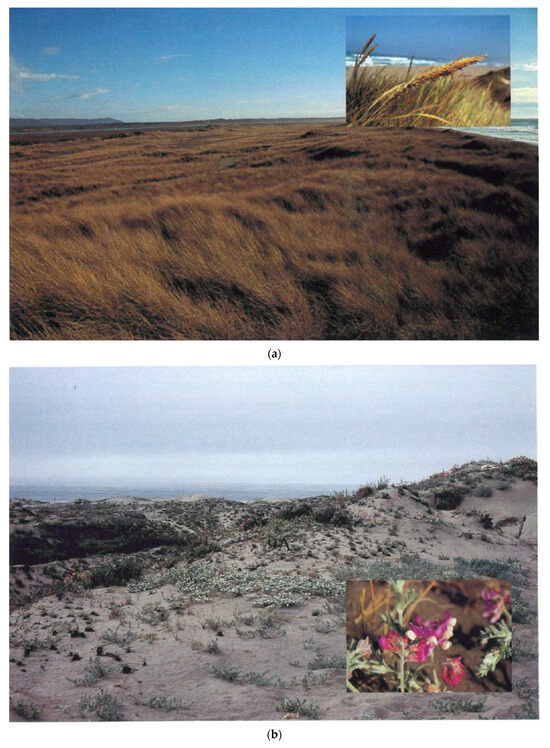
Figure 18.
(a). Marram grass (European beachgrass) invasion of the Lake Earl Dunes, Northern California, where cover is up to 100% on the foredune complex, formerly shifting dunes. Inset: Marram grass (Ammophila arenaria) in flower. (b). Compare this with the diverse flora of a dune mat on the Lanphere-Christensen Dunes Preserve Humbolt Bay dunes. Inset: Beach pea—Lathyrus littorals (source [89]). There are many other examples in this publication.
The New Wild concept is also unlikely to be accepted for the Cape Fynbos, where alien invaders, mainly Australian woody species, would otherwise likely eliminate many of the indigenous plant species. The unique flora of the Cape Floristic Region is worth fighting for by the continual removal of the alien plants. I have not been impressed on the nature of the “new” vegetation when visiting island countries such as New Zealand or St Helena. St Helena has a vegetation type reminiscent of the European countries from where many of the human settlers came. The indigenous vegetation has been devastated and all endemic species are scarce.
I wrote a review of The New Wild [90], in which I concluded: “What Pearce proposes as the ‘new wild’ will certainly occur sometime in the future. Ecologists cannot indefinitely eradicate all aliens from ‘pristine’ or even slightly disturbed environments. We will have to limit our resources to some areas, while allowing new systems—the new wild—to develop in others. Moreover, humans might not be present on this planet forever. Then, as Pearce claims in his final paragraph, ‘nature never goes back; it always moves on’. The vagabonds or aliens will be the pioneers and colonists in this constant renewal, and the new wild will become a reality across the planet”.
6. Overall Conclusions
On the basis of the review of these studies on restoration or rehabilitation in many projects in eastern and southern Africa (Figure 1 showing the localities of the sites) we can conclude that:
- Before a restoration programme is prepared, one needs to examine the current land use.
- Then, goals can be formulated to meet the needs of the local community.
- There is little to be gained from establishing elaborate restoration programmes if the final land use is of little benefit, especially conservation of the previous environment merely for the sake of showing that is possible.
- Stabilisation of tailings is often necessary to prevent migration into adjacent areas or the loss of tailings as dust.
- It is important to create an aesthetically pleasing environment, so the establishment of vegetation on tailings or the area of disturbance is the best option.
- Knowledge of the succession process in the natural ecosystems should be a prerequisite, as restoration often mimics the process of natural succession.
- Replacement is the substitution of an alternative vegetation or crop rather than returning the site to the previous vegetation.
- A thorough knowledge of the properties of the tailings is an essential component of the study, as “soil” is important for the growth of the plants.
- It may be especially important to choose plants that are suited to the particular conditions of the tailings.
- It is necessary to monitor the success of the restoration programme for at least 10 years.
- It is unlikely that accepting the “New Wild” composed of invasive species will have much bearing on the restoration movement, as the view of a natural environment is the goal of most restoration ecologists.
Funding
This research received no external funding.
Data Availability Statement
No new data were created or analyzed in this study. Data sharing is not applicable to this article.
Acknowledgments
This paper was originally presented at the Restore Kalahari Conference held at Namakwari Lodge, Kathu, 17 March 2023. I am grateful to Rhodes University for providing travel funds to attend the conference. I also thank the Department of Botany at Rhodes University for providing facilities for my research and teaching for almost 50 years. Robert McKenzie provided valuable input on the English and scientific content, and I thank him sincerely for his contributions. Finally, my thanks to three anonymous referees who provided valuable comments that led to improvements to this paper.
Conflicts of Interest
The author declares no conflict of interest.
References
- Bradshaw, A.D.; Chadwick, M.J. The Restoration of Land: The Ecology and Reclamation of Derelict and Degraded Land; Blackwell: Oxford, UK, 1980. [Google Scholar]
- Bradshaw, A.D. The reconstruction of ecosystems: Address to the British Ecological Society December 1982. J. Appl. Ecol. 1983, 20, 1–17. [Google Scholar] [CrossRef]
- Bradshaw, A.D. Ecological principles and land reclamation practices. Landsc. Plan. 1984, 11, 35–48. [Google Scholar] [CrossRef]
- Society Ecological Restoration International Science & Policy Working Group. The SER International Primer on Ecological Restoration; Society for Ecological Restoration International: Tucson, AZ, USA, 2004; Available online: http://www.ser-rrc.org/resource/the-ser-international-primer-on/ (accessed on 15 September 2023).
- Lubke, R.A. Erosion of the beach at St Francis Bay, Eastern Cape, South Africa. Biol. Conserv. 1985, 32, 99–127. [Google Scholar] [CrossRef]
- Lubke, R.A.; Avis, A.M. Succession on the coastal dunes and dune slacks at Kleinemonde, Eastern Cape, South Africa. Monogr. Syst. Bot. Mo. Bot. Gard. 1988, 25, 599–622. [Google Scholar]
- Lubke, R.A.; Gess, F.W.; Bruton, M.N. (Eds.) A Field Guide to the Eastern Cape Coast; Grahamstown Centre of the Wildlife Society of Southern Africa: Grahamstown, South Africa, 1988. [Google Scholar]
- Avis, A.M. Coastal Management and Stabilisation of Mobile Dune Systems. Ph.D. Thesis, Rhodes University, Grahamstown, South Africa, 1992. [Google Scholar]
- Lubke, R.A.; Avis, A.M.; Steinke, T.D.; Boucher, C. Coastal vegetation. In Vegetation of Southern Africa; Cowling, R.M., Richardson, D.M., Pierce, S.M., Eds.; Cambridge University Press: Cambridge, UK, 1997; pp. 300–321. [Google Scholar]
- Lubke, R.A. Current state of Ammophila arenaria (marram grass) distribution in the Eastern Cape, South Africa, and the possible effect of the grass on the dune system dynamics. Plants 2022, 11, 2260. [Google Scholar] [CrossRef]
- Lubke, R.A.; Hertling, U. Use of Ammophila arenaria for dune stabilization in South Africa and its current distribution—Perceptions and problems. Environ. Manag. 1999, 24, 467–482. [Google Scholar] [CrossRef]
- Lubke, R.A.; Hertling, U.M. The role of European marram grass in dune stabilization and succession near Cape Agulhas, South Africa. J. Coast. Conserv. 2001, 7, 171–182. [Google Scholar] [CrossRef]
- Jordan, W.R.; Gilpin, M.E.; Aber, J.D. Restoration Ecology: A Synthetic Approach to Ecological Research; Cambridge University Press: Cambridge, UK, 1990; 340p. [Google Scholar]
- Parker, V.T.; Pickett, S.T.A. Restoration as an ecosystem process: Implications of the modern ecological paradigm. In Restoration Ecology and Sustainable Development; Urbanska, K.M., Webb, N.R., Edwards, P.J., Eds.; Cambridge University Press: New York, NY, USA, 1997; pp. 17–32. [Google Scholar]
- Atlas, R.M.; Bartha, R. Microbial Ecology: Fundamentals and Applications; Addison-Wesley Publishing Co.: Reading, MA, USA, 1993. [Google Scholar]
- Cairns, J. Is restoration ecology practical? Restor. Ecol. 1993, 1, 3–7. [Google Scholar] [CrossRef]
- Van Aarde, R.J.; Ferreira, S.M.; Kritzinger, J.J.; Van Dyk, P.J.; Vogt, M.; Wassenaar, T.D. An evaluation of habitat rehabilitation on coastal dune forests in northern KwaZulu-Natal, South Africa. Restor. Ecol. 1996, 4, 334–345. [Google Scholar] [CrossRef]
- Higgs, E. What is good ecological restoration? Conserv. Biol. 1997, 11, 338–348. [Google Scholar] [CrossRef]
- Lubke, R.A. Environmental rehabilitation. S. Afr. J. Sci. 1995, 91, 568–569. [Google Scholar]
- IUCN Rewilding Thematic Group. Available online: https://www.iucn.org/our-union/commissions/group/iucn-cem-rewilding-thematic-group (accessed on 14 September 2023).
- Pearce, F. The New Wild: Why Invasive Species Will Be Nature’s Salvation; Beacon Press: Boston, MA, USA, 2017. [Google Scholar]
- Hobbs, R.J.; Higgs, E.; Harris, J.A. Novel ecosystems: Implications for conservation and restoration. Trends Ecol. Evol. 2009, 24, 599–605. [Google Scholar] [CrossRef] [PubMed]
- Lubke, R.A.; Avis, A.M.; Phillipson, P.B. Vegetation and floristics. In Environmental Impact Assessment. Eastern Shores of Lake St Lucia (Kingsa/Trojan Lease Area). Specialist Reports; Coastal & Environmental Services: Grahamstown, South Africa, 1992; 741p. [Google Scholar]
- Richards, I.G.; Palmer, J.P.; Barratt, P.A. The Reclamation of Former Coal Mines and Steelworks; Elsevier: Amsterdam, The Netherlands, 1993; 771p. [Google Scholar]
- Grange, G.H. The control of dust from mine dumps. J. S. Afr. Inst. Min. Metall. 1973, 74, 67–73. [Google Scholar]
- Thatcher, F.M. A Study of the Vegetation Established on Mine Dumps of the Witwatersrand 1973–1979. Ph.D. Thesis, University of the Witwatersrand, Johannesburg, South Africa, 1984. [Google Scholar]
- Cook, B. Growing Vegetation on Mine Residue Dumps. Unpublished Manuscript, No Date. 6p.
- James, A.L. Stabilizing mine dumps with vegetation. Endeavour 1966, 25, 154–157. [Google Scholar] [CrossRef]
- Shaughnessy, G.L. Historical Ecology of Alien Woody Plants in the Vicinity of Cape Town. Ph.D. Thesis, University of Cape Town (School of Environmental Studies Report No. 23), Cape Town, South Africa, 1980; 421p. [Google Scholar]
- Avis, A.M. A review of coastal dune stabilisation in the Cape Province of South Africa. Landsc. Urban Plan. 1989, 18, 55–68. [Google Scholar] [CrossRef]
- Knevel, I.C.; Venema, H.G.; Lubke, R.A. The search for indigenous dune stabilizers: Germination requirements of selected South African species. J. Coast. Conserv. 2002, 8, 169–178. [Google Scholar] [CrossRef]
- Hilton, M.J. The loss of New Zealand’s active dunes and the spread of marram grass (Ammophila arenaria). N. Z. Geogr. 2006, 62, 105–120. [Google Scholar] [CrossRef]
- CES. Risk Assessment for the Use of Marram Grass for Dune Rehabilitation and Management Projects in the City of Cape Town Metropolitan Areas; Coastal & Environmental Services: Cape Town, South Africa, 2017. [Google Scholar]
- Avis, A.M. An evaluation of the vegetation developed after artificially stabilising South African coastal dunes with indigenous species. J. Coast. Conserv. 1995, 1, 41–50. [Google Scholar] [CrossRef]
- Hertling, U.M. An Autecological Study of Ammophila arenaria and Alternative Indigenous Species Used in Dune Stabilisation on the Cape Coast. Ph.D. Thesis, Rhodes University, Grahamstown, South Africa, 1997. [Google Scholar]
- Lubke, R.; Avis, T.; Higgins, U.; Knevel, I.; Van Eeden, D. The scientific community accepts marram grass to be non-invasive in dune stabilisation in the Cape. S. Afr. J. Sci. 2023, 119, 15107. [Google Scholar] [CrossRef]
- Avis, A.M.; Lubke, R.A. Dynamics and succession of coastal dune vegetation in the Eastern Cape, South Africa. Landsc. Urban Plan. 1996, 34, 237–254. [Google Scholar] [CrossRef]
- Knevel, I.C. The Life History of Selected Coastal Foredune Species of South Africa. Ph.D. Thesis, Rhodes University, Grahamstown, South Africa, 2001. [Google Scholar]
- Hertling, U.M.; Lubke, R.A. Indigenous and Ammophila arenaria-dominated dune vegetation on the South African Cape coast. Appl. Veg. Sci. 1999, 2, 157–168. [Google Scholar] [CrossRef]
- Konlechner, T.M.; Hilton, M.J. The potential for marine dispersal of Ammophila arenaria (marram grass) rhizome in New Zealand. J. Coast. Res. 2009, 43, 434–437. [Google Scholar]
- Butchart Gardens. Available online: https://www.butchartgardens.com/ (accessed on 10 September 2023).
- Avis, A.M.; Blood, J.R. Corridor Sands EIA, Volume 2: Specialist Reports; Coastal & Environmental Services: Grahamstown, South Africa, 2001. [Google Scholar]
- Harris, J. At the 17th International Conference of the Society of Ecological Restoration, Zaragosa, Spain. 12–18 September 2005. [Google Scholar]
- Hobbs, R.J.; Harris, J.A. Restoration ecology: Repairing the Earth’s ecosystems in the new millennium. Restor. Ecol. 2001, 9, 239–246. [Google Scholar] [CrossRef]
- Lubke, R.A. Vegetation dynamics and succession on sand dunes of the eastern coasts of Africa. In Coastal Dunes: Ecology and Conservation; Martinez, M.L., Psuty, N.P., Eds.; Ecological Studies; Springer: Berlin, Germany, 2004; Volume 171, pp. 67–84. [Google Scholar]
- Clements, F.E. Plant succession: Analysis of the development of vegetation. Publ. Carnegie Instit. Wash. 1916, 242, 1–512. [Google Scholar]
- Connell, J.H.; Slatyer, R.O. Mechanisms of succession in natural communities and their role in community stability and organisation. Am. Nat. 1977, 111, 1119–1144. [Google Scholar] [CrossRef]
- Lubke, R.A.; Avis, A.M. Factors affecting the distribution of Scirpus nodosus plants in a dune slack community. S. Afr. J. Bot. 1982, 1, 97–103. [Google Scholar] [CrossRef]
- Lubke, R.A.; Avis, A.M. The effect of salt spray on the growth of Scirpus nodosus. S. Afr. J. Bot. 1982, 1, 163–164. [Google Scholar] [CrossRef]
- Lubke, R.A.; Avis, A.M. The effect of wind-borne sand and salt spray on the growth of Scirpus nodosus in a mobile dune system. S. Afr. J. Bot. 1985, 51, 100–110. [Google Scholar]
- Tinley, K.L. Coastal Dunes of South Africa; South African National Scientific Programmes Report 109; CSIR: Pretoria, South Africa, 1985. [Google Scholar]
- Weisser, P.J.; Marques, F. Gross vegetation changes in the dune area between Richards Bay and the Mfolozi River, 1937–1974. Bothalia 1979, 12, 711–721. [Google Scholar] [CrossRef]
- Weisser, P.J. The dune forest of Maputaland. In Studies on the Ecology of Maputaland; Bruton, M.N., Cooper, K.H., Eds.; Rhodes University and the Natal Branch Wildlife Society, Southern Africa: Grahamstown, South Africa, 1980; pp. 78–101. [Google Scholar]
- Lubke, R.A.; Avis, A.M.; Moll, J.B. Post-mining rehabilitation of coastal sand dunes in Zululand, South Africa. Landsc. Urban Plan. 1996, 34, 335–345. [Google Scholar] [CrossRef]
- Apfelbaum, S.I.; Haney, A. Restoring Ecological Health to Your Land; Island Press: Washington, DC, USA, 2010. [Google Scholar]
- Chenik, D.J. The promotion of vegetation cover on mine slimes dams and sand dumps. J. S. Afr. Inst. Min. Metall. 1960, 60, 525–555, 744–751. [Google Scholar]
- Groves, J.E. Reclamation of mining degraded land. S. Afr. J. Sci. 1974, 70, 296–299. [Google Scholar]
- Kneen, M.A.; Ojelede, M.E.; Annegarn, H.J. Housing and population sprawl near tailings storage facilities in the Witwatersrand: 1952 to current. S. Afr. J. Sci. 2015, 111, 1–9. [Google Scholar] [CrossRef]
- Smith, R.A.; Bradshaw, A.D. Stabilisation of toxic mine wastes by the use of tolerant plant populations. Trans. Inst. Mining Metall. Mining Technol. 1972, 81, A230–A237. [Google Scholar]
- Bradshaw, A.D. Populations of Agrostis tenuis: Resistance to lead and zinc poisoning. Nature 1952, 169, 1098. [Google Scholar] [CrossRef]
- Hill, J.R.C.; Nothard, W.F. The Rhodesian approach to vegetating slimes dams. J. S. Afr. Inst. Min. Metall. 1973, 74, 197–208. [Google Scholar]
- Weiersbye, I.M.; Witkowski, E.T.F. Impacts of acid mine drainage on the regeneration potential of highveld phreatophyte plants. In Multiple Use Management of Natural Forests and Savanna Woodlands: Policy Refinements and Scientific Progress IV; Bester, J.J., Seydack, A.H.W., Vorster, T., Vermeulen, W.J., Van der Merwe, I.J., Eds.; Department of Water Affairs and Forestry of South Africa: Pretoria, South Africa, 2007; pp. 221–255. [Google Scholar]
- Weiersbye, I.M.; Witkowski, E.T.F.; Reichardt, M. Floristic composition of gold and uranium tailings dams, and adjacent polluted areas, on South Africa’s deep-level mines. Bothalia 2006, 36, 101–127. [Google Scholar] [CrossRef][Green Version]
- Sutton, M.W.; Weiersbye, I.M. Land use after mine closure—Risk assessment of gold and uranium mine residue deposits on the eastern Witwatersrand, South Africa. In Mine Closure 2008; Fourie, A.B., Tibbett, M., Weiersbye, I.M., Dye, P.J., Eds.; Australian Centre for Geomechanics: Perth, Australia, 2008; ISBN 978-0-9804185-6-9. [Google Scholar]
- Mail & Guardian. Jo’burg Mine Dumps Still Yield Treasure. Reported by Celean Jacobson. Mail & Guardian, 16 April 2007. Available online: https://mg.co.za/article/2007-04-16-joburg-mine-dumps-still-yield-treasure/ (accessed on 15 September 2023).
- Mabaso, S.M. Legacy gold mine sites and dumps in the Witwatersrand: Challenges and required action. Nat. Resour. 2023, 14, 65–77. [Google Scholar] [CrossRef]
- Mulugisi, G.; Gumbo, J.R.; Dacosta, F.A.; Muzerengi, C. The Use of Indigenous Grass Species as Part of Rehabilitation of Mine Tailings: A Case Study of New Union Gold Mine; International Mine Water Conference: Pretoria, South Africa, 2009. [Google Scholar]
- Moorhouse-Gann, R. Ecological Replacement as a Restoration Tool: Disentangling the Impacts of Aldabra Giant Tortoises (Aldbrachelys gigantea) Using DNA Metabarcoding. Ph.D. Thesis, Cardiff University, Cardiff, UK, 2017. [Google Scholar]
- Temple, S. Plant-animal mutualism: Coevolution with dodo leads to near extinction of plant. Science 1977, 197, 885–888. [Google Scholar] [CrossRef]
- Witmer, M.C.; Clarke, A.S. The dodo and the tambalacoque tree: An obligate mutualism reconsidered. Oikos 1991, 61, 133–137. [Google Scholar] [CrossRef]
- Ranjan, V.; Sen, P.; Kumar, D.; Sarsawat, A. A review on dump slope stabilization by revegetation with reference to indigenous plant species. Ecol. Processes 2015, 4, 14. [Google Scholar] [CrossRef]
- Drury, W.; Nisbet, I. Succession. J. Arnold Arbor. 1973, 54, 331–368. [Google Scholar] [CrossRef]
- Olson, J.S. Rates of succession and soil changes on southern Lake Michigan sand dunes. Bot. Gaz. 1958, 119, 125–170. [Google Scholar] [CrossRef]
- Picket, S.T.A.; Collins, S.; Armesto, J.J. A hierarchical consideration of causes and mechanisms of succession. In Theory and Models in Vegetation Science; Advances in Vegetation Science; Prentice, I.C., Van der Maarel, E., Eds.; Dr. W. Junk Publishers: Dordrecht, The Netherlands, 1987; Volume 8, pp. 109–114. [Google Scholar]
- Salisbury, E.J. Note on the edaphic succession in some dune soils with special reference to the time factor. J. Ecol. 1925, 13, 322–328. [Google Scholar] [CrossRef]
- Smith, S.M.; Allen, R.B.; Daly, B.K. Soil-vegetation relationships on a sequence of sand dunes, Tautuku Beach, south-east Otago, New Zealand. J. R. Soc. N. Z. 1985, 15, 295–312. [Google Scholar] [CrossRef]
- Mentis, M.T.; Ellery, W.N. Post-mining rehabilitation of dunes on the northeast coast of South Africa. S. Afr. J. Sci. 1994, 90, 69–74. [Google Scholar]
- Everard, D.; Von Maltitz, G.P. (Eds.) Dune Forest Dynamics in Relation to Land-Use Practices; Foundation for Research Development: Pretoria, South Africa, 1991. [Google Scholar]
- Von Maltitz, G.P.; Van Wyk, G.F.; Everard, D.A. Successional pathways in disturbed coastal dune forest on the coastal dunes in north-east KwaZulu-Natal, South Africa. S. Afr. J. Bot. 1996, 62, 188–195. [Google Scholar] [CrossRef]
- Lubke, R.A.; Avis, A.M. A review of the concepts and application of rehabilitation following heavy mineral dune mining. Mar. Pollut. Bull. 1998, 37, 546–557. [Google Scholar] [CrossRef]
- Van Aarde, R.J.; Ferreira, S.M.; Kritzinger, J.J. Millipede communities in rehabilitating coastal dune forests in northern KwaZulu/Natal. S. Afr. J. Zoo. 1996, 238, 703–712. [Google Scholar] [CrossRef]
- Wassenaar, T.D.; Van Aarde, R.J.; Pimm, S.L.; Ferreira, S.M. Community convergence in disturbed subtropical dune forests. Ecology 2005, 86, 655–666. [Google Scholar] [CrossRef]
- Van Aarde, R.J.; Ferreira, S.M.; Kritzinger, J.J. Successional changes in rehabilitating coastal dune communities in northern KwaZulu-Natal, South Africa. Restor. Ecol. 1996, 4, 334–345. [Google Scholar] [CrossRef]
- Grainger, M.J.; Van Aarde, R.J. Is succession-based management of a coastal dune forest restoration valid? Ecol. Restor. 2012, 30, 200–208. [Google Scholar] [CrossRef][Green Version]
- Gleason, H.A. The individualistic concept of the plant association. Bull. Torrey Bot. Club 1926, 53, 7–26. [Google Scholar] [CrossRef]
- CES. A Sustainability Analysis of Various Land Use Alternatives to Determine Optimum Land Use for the Future Rehabilitation of Lease Areas at Richards Bay Minerals; Report Prepared for RBM; Coastal & Environmental Services: Grahamstown, South Africa, 2006. [Google Scholar]
- Lovelock, J. Gaia: A New Look at Life on Earth; Oxford University Press: Oxford, UK, 1979. [Google Scholar]
- Geshko, M. New Zealand Announces Plan to Wipe Out Invasive Predators. National Geographic, 25 July 2016. Available online: https://www.nationalgeographic.com/science/article/new-zealand-invasives-islands-rats-kiwis-conservation// (accessed on 8 September 2023).
- Pickart, A.J.; Sawyer, J.O. Ecology and Restoration of Northern California Coastal Dunes; California Native Plant Society: Sacramento, CA, USA, 1998; 151p. [Google Scholar]
- Lubke, R.A. The new wild: The uncomfortable truth. S. Afr. J. Sci. 2016, 112, 2. [Google Scholar] [CrossRef]
Disclaimer/Publisher’s Note: The statements, opinions and data contained in all publications are solely those of the individual author(s) and contributor(s) and not of MDPI and/or the editor(s). MDPI and/or the editor(s) disclaim responsibility for any injury to people or property resulting from any ideas, methods, instructions or products referred to in the content. |
© 2023 by the author. Licensee MDPI, Basel, Switzerland. This article is an open access article distributed under the terms and conditions of the Creative Commons Attribution (CC BY) license (https://creativecommons.org/licenses/by/4.0/).